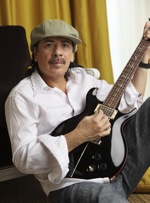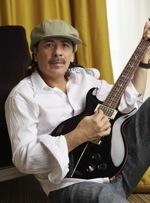Bless Michael Morgan. With last weekend’s program, the ambitious music director of the Oakland East Bay Symphony again delivered on his commitment to do everything in his power to serve the diverse Bay Area community and widen the circle of symphony attendees.

This time, he reached out to young people, baby boomers, parents, New Age spirit-seekers, people of Hispanic and African-American ancestry, and just about everyone else under the sun. But not even a star-studded season opener featuring triple Grammy winner Narada Michael Walden, 10-time Grammy winner Carlos Santana, a generous helping of world-class musicians and vocalists, the Oakland Interfaith Gospel Choir, young dancers from the Oakland Ballet School, soloists from the Piedmont East Bay Children’s Choir, and a production that included a verdant mini–light show could ensure that what the incredibly gifted artists onstage wished to communicate could actually reach the audience’s ears in coherent form.
What is not currently in Morgan’s power is the ability to do anything about the Paramount Theatre’s horrible acoustic. This treasure of an art deco movie palace boasts wondrous architecture that has been restored to joyful, eye-popping estate, yet its ability to suck up the sound of a full orchestra, and even of amplified musicians, makes the extreme dryness of San Francisco’s Herbst Theatre seem like a godsend.
In the lower balcony, whose acoustics are better than the ground floor’s, I was at a loss to decipher the muddle of sound that ensued every time the assembled forces let loose. It’s sad enough that, in the Paramount, vibrant colors are normally bleached into a palette of muted grays. But when Karl Perazzo and Cindy Blackman Santana’s phenomenal percussion, Santana’s electric guitar, the OEBS, and up to two keyboardists and 30 vocalists got going all at once, they might as well have been playing in a BART train traversing the San Francisco/East Bay tube. It really was that bad.
It’s not as if Morgan is unaware of the problem. In private discussion sometime back, he expressed guarded optimism that something could be done. Then Oakland’s budget crisis hit, and what Morgan hoped for seemed pretty hopeless. If Morgan has a Plan B up his sleeve, more power to him.
Music Both Familiar and Novel
The evening began with Mexico’s unofficial second national anthem, Arturo Márquez’ Danzón No. 2. The stage setup was novel, with clusters of musicians facing the left corner of the stage, where Morgan had been moved so that the percussionists’ flower-strewn podium and assorted electronica could inhabit the rest of the space. OEBS did a lovely job with Danzón. Even if the violinists didn’t slash through their notes where the music requires, the joyous performance served as a perfect prelude for what was to follow.
Thanks to John Kendall Bailey, who transcribed music from recordings, the orchestra was joined by Santana, Mathews, Perazzo, and Blackman Santana in a performance of Alice Coltrane’s Andromeda’s Suffering. There were some moving moments when the soloists let loose, one at a time, but, again, the combined din was little more than a muddle.
Similarly, more than an electric instrument wept during Santana, Matt Serlectic’s, and Bailey’s orchestration of George Harrison’s While My Guitar Gently Weeps. It was next to impossible to make out Walden’s drums, Daniel Reiter’s cello, and Nikita Germaine’s vocals amid the din from Santana, keyboardist David Matthews, and percussionist Perazzo.
At least the melodies were sufficiently recognizable to elicit appreciation. What was decipherable of Novus, an original Santana collaboration with Placido Domingo that made it onto a 2002 CD, was less impressive. Vocalist Kalil Wilson, in his few lines that were exposed enough to transcend the din, indulged in barely sufferable sentiment, and the music sounded overblown and bombastic. The lyrics may have extolled a future of peace and harmony, but the performance sounded lamentably earthbound.
Narada Michael Walden World Premiere
As Walden explained in the program notes, the idea for his symphony, Enchanted Forest: Seven Higher Worlds of Music, came to him when he was 18 years old, “sitting under a tree which seemed to be illuminated by an inner light.” Thanks to the OEBS’ wonderful New Visions/New Vistas Commissioning Project, with support from the James Irvine Foundation and East Bay Fund for Artists at the East Bay Community Foundation, the work has finally taken form.
Dedicated to Walden’s parents, the symphony’s seven movements bear titles such as “The Journey Love,” “Surrender,” and “All Are Harmonious.” At its center is the composer/drummer himself.
Melodies that could be deciphered were for the most part lovely, displaying the craft that makes Walden’s music so enjoyable. Attired in white top hat and tails, Walden strode onto a stage that included a tree strewn with electric lights. Those lights flashed as the assembled forces, including many yelping and cheering audience members, went hog wild. If the archival recording by mastering and sound engineer Michael Romanowski is ever released, we’ll be able to fully assess Walden's accomplishment.

